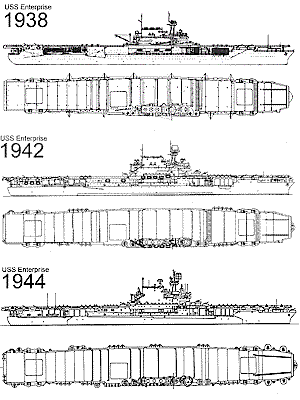 Three views of Enterprise CV-6, from 1938 to 1944, courtesy of Gordon G. Buttars. Click an image for an enlarged sketch of how the carrier appeared in 1938, 1942 and 1944. |
History:
Prewar -
1941 -
1942 -
1943 -
1944 -
1945 -
Postwar
The Ship -
All Hands -
Decorations -
Remembrance
 Three views of Enterprise CV-6, from 1938 to 1944, courtesy of Gordon G. Buttars. Click an image for an enlarged sketch of how the carrier appeared in 1938, 1942 and 1944. |
Enterprise CV-6 was the second of the three Yorktown-class carriers. One of the most successful warship designs in history, the Yorktown-class carriers were built with the experience gained from earlier carrier designs: Lexington CV-2 and Saratoga CV-3, which were built on converted battle-cruiser hulls, and Ranger CV-4, the first US carrier specifically designed as a carrier.
Enterprise, and her sister ships Yorktown CV-5 and Hornet CV-8, while of a third smaller displacement than Lexington and Saratoga, could carry practically the same number of aircraft, and 30% more aviation fuel. In other words, they could deliver the same offensive punch more times, and more efficiently. The Yorktown-class carriers were exceptionally seaworthy, and more maneuverable than their predecessors. In keeping with American carrier doctrine, they sacrificed armor and guns to maximize the number of attack planes carried. Yet, with hundreds of watertight internal compartments, they were also capable of surviving terrific battle damage.
Perhaps their primary weakness as designed was vulnerability to torpedo attack. Both Yorktown (at Midway) and Hornet (at Santa Cruz) were severely damaged by Japanese torpedoes, though it's worth noting that both ships put up considerable resistance to actually sinking afterwards. It is also noteworthy that of the all the US fleet carriers to serve in the Pacific in the first year of the war, Enterprise was the only one not to be struck by an enemy torpedo ... and near the end of that first year, she was also the only battle-ready US fleet carrier. As part of her 1943 refit at Bremerton, Washington, Enterprise acquired a torpedo blister along three quarters of her hull, above and below waterline.
Her war-time modifications also reflected the nature of the Pacific war. After the tremendous carrier battles of 1942, it was clear that anti-aircraft protection was a vital component of any surface ship's armament. By the end of 1943, Enterprise and most other combatants in the US fleet bristled with 20mm and Bofors 40mm anti-aircraft guns, two of the most effective anti-aircraft weapons of the war. Radar-controlled fire directors for both the 5" and 40mm guns - added in 1943 - gave Enterprise the ability to beat back attacking aircraft in all weather, day or night.
Overall Dimensions | ||
|---|---|---|
| As Commissioned | Post-1943 Refit (Bremerton) | |
| Displacement | 19,800 tons standard, 25,500 tons full load | 21,000 tons standard, 32,060 tons full load |
| Draught | 21-ft 8-in standard, 27-ft 11-in full load | |
| Length (Overall) | 809-ft 6-in | 827-ft 5-in |
| Length (Waterline) | 761-ft | 761-ft |
| Width (Overall) | 108-ft 11-in | 114-ft 2-in |
| Beam | 83-ft 2-in | 95-ft 5-in |
| Height (Overall) | 143-ft | 143-ft |
Flight and Hangar Decks |
||
| Flight Deck | 802-ft x 86-ft | |
| Hangar Deck | 546-ft x 63-ft x 17-ft 3-in | |
| Elevators | 3 48-ft x 44-ft, capacity 17,000lbs | |
Propulsion and Power Plant |
||
| Propulsion | 4 Parsons single reduction geared steam turbines, powered by 9 Babcock & Wilcox 400 psi boilers | |
| Shaft Horsepower | 120,000 hp (4 shafts) | |
| Maximum Speed | 32.5 knots (37.6 mph); 33.65 knots in trials | |
| Fuel Capacity | 6,500 tons (more than 1.5 million gallons) | |
| Endurance | 10,400 nautical miles at 15 knots; 7,900 nm at 20 knots | |
Miscellaneous |
||
| Aircraft Capacity | 96 maximum: more typically 80-90 were on board | |
| Armor | 4.8" at waterline, 1.5" at deck, 4.0" fire control centers | |
| Aviation Gas Stock | 178,000 gallons | |
| Aviation Ordnance | 433 tons capacity | |
| Catapults: Flight Deck | One H MK II (7000 lbs to 70 mph in 55-ft) | Two H 2-1 (11,000 lbs to 70 mph in 73-ft) |
| Catapults: Hangar Deck | Two H MK II | None |
| Complement | 1889 in peace-time, 2919 (peak) at war | |
Image Library -
Action Reports and Logs -
News Stories
Message Boards -
Bookstore -
Enterprise CV-6 Association
Copyright © 1998-2003 Joel Shepherd ([email protected])
Sources and Credits